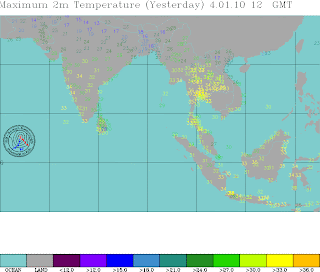Summing up of January Weather For the Indian Region:
Weather wise, It has been an odd and "different" January 2010 for the Indian region.
As a starter,to analyse the the average temperatures observed this winter, we divide the region.
For the North, the average temperature, for most of the month, has been below normal. Picking up 2 cities from the region, Delhi and Amritsar, the daigram shows the major part of January in "blue". Now, this is basically due to the "super" cold days, and not cold nights ( as we would normally expect).
Fog, dense fog, prevailed over Haryana, Chandigarh & Delhi, Uttar Pradesh and Bihar on most days of the month.Thus keeping the days much below normal. Day temperatures were as much as 12c below normal on certain days in some cities. Delhi hovered around 12c and Amritsar around 10c on certain days.
Now, the anomaly temperature map, of the last week shows it all.
Contrary to this, the Western region of the country almost had a heat Wave!! In one blog, I had mentioned this, with Mumbai going up to 35c, in mid January ! (Mumbai diagram..RED all the way!!) Yes, its been really hot with temperatures still refusing to slide down, and averaging34/35c throughout this month. Goa was 35c today, 29th. Jan !
Typically pleasant cities like Pune, which would normally touch a low of 6c, has seen 9c on only 1 day, and has otherwise been averaging around 13/14c.
Mumbai has had a low of 19c on one day,(14c in the suburbs). While, on a good winter's night, we can easily read 15c in the city amd 10c in the suburbs.
Same story along the Southern regions, and the temperatures never really dropped this winter in the Southern and Central parts of India. One can say the states barring the Northern states, had just about an average winter.
And, with hardly any W.D, worth its name, the normally rainy regions (North) remained practically dry. Only one good snowfall during January in the hills.
IMD rain map shows the entire North as deficient.
And this is the region that actually requires, and recieves good rains/snow in winter.
Mark has put up a beautiful forecast for February..for his region in Scotland..and believe me..his estimates are too good !!
kapadias@gmail.com





















